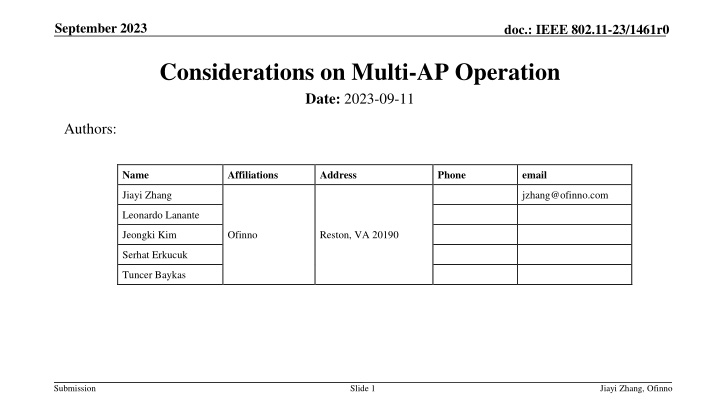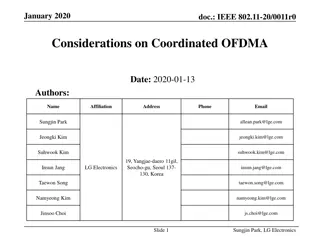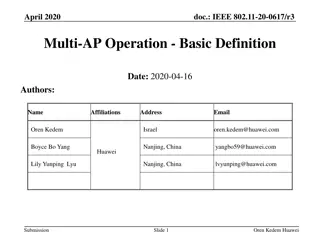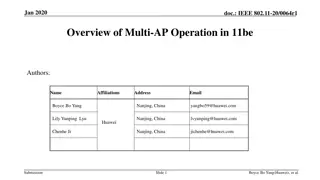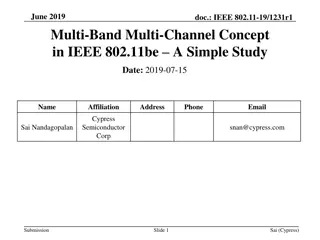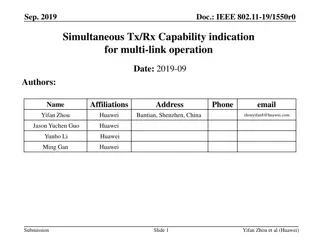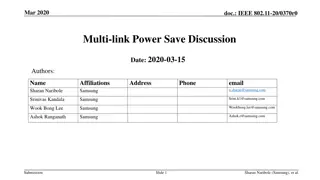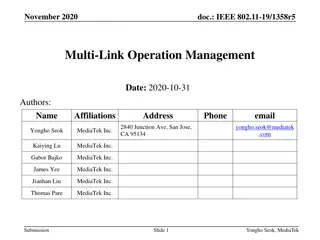Considerations on Multi-AP Operation in IEEE 802.11-23/1461r0
This document discusses considerations for multi-AP operation within IEEE 802.11 standards, focusing on selecting transmission schemes and scheduling for optimal performance. It explores the phases involved in multi-AP setup, coordination, selection, channel sounding, data sharing, and data transmission. The goal is to enhance Ultra High Reliability (UHR) capability in wireless networks to improve reliability, reduce latency, and lower power consumption compared to existing operations.
Download Presentation

Please find below an Image/Link to download the presentation.
The content on the website is provided AS IS for your information and personal use only. It may not be sold, licensed, or shared on other websites without obtaining consent from the author.If you encounter any issues during the download, it is possible that the publisher has removed the file from their server.
You are allowed to download the files provided on this website for personal or commercial use, subject to the condition that they are used lawfully. All files are the property of their respective owners.
The content on the website is provided AS IS for your information and personal use only. It may not be sold, licensed, or shared on other websites without obtaining consent from the author.
E N D
Presentation Transcript
September 2023 doc.: IEEE 802.11-23/1461r0 Considerations on Multi-AP Operation Date: 2023-09-11 Authors: Name Affiliations Address Phone email Jiayi Zhang jzhang@ofinno.com Leonardo Lanante Jeongki Kim Ofinno Reston, VA 20190 Serhat Erkucuk Tuncer Baykas Submission Slide 1 Jiayi Zhang, Ofinno
September 2023 doc.: IEEE 802.11-23/1461r0 Abstract In this contribution, we share some considerations on multi-AP operation, including the support of selecting multi-AP transmission schemes and the support of scheduling the multi-AP transmission. Submission Slide 2 Jiayi Zhang, Ofinno
September 2023 doc.: IEEE 802.11-23/1461r0 Introduction In PAR of P802.11bn, the Ultra High Reliability (UHR) capability has been defined to improve Rate-vs-Range enchantment, reduce latency, and reduce power consumption for AP, compared to Extremely High Throughput (EHT) MAC/PHY operation. Multi-AP operation (aka. Multi-AP coordination/transmission) has been discussed as one of the key candidate features to meet the requirement of UHR capability. Submission Slide 3 Jiayi Zhang, Ofinno
September 2023 doc.: IEEE 802.11-23/1461r0 Multi-AP Operation Recap (1) [1~8] Multi-AP operation may include several phases/procedures between OBSSs. Multi-AP setup phase: Exchanging information between multiple APs; Grouping multiple candidate APs, e.g., AP candidate sets, Multi-AP coordination phases Exchanging information between sharing AP and shared AP(s), Multi-AP selection phase: sharing AP selects shared AP(s), Multi-AP channel sounding phase (optional): APs perform sounding jointly/individually with STA(s). Multi-AP data sharing phase (optional): sharing AP shares data to shared AP Multi-AP data transmission phase: Using UL/DL multi-AP transmission schemes, such as: coordinated spatial reuse (CSR), coordinated OFDMA/TDMA, coordinated beamforming (CBF), joint transmission/reception (JT/JR), etc. Submission Slide 4 Jiayi Zhang, Ofinno
September 2023 doc.: IEEE 802.11-23/1461r0 Multi-AP Operation Recap (2) [1~8] Multi-AP operation procedures may be performed for long-term or short-term operations: Long-term operation: e.g., one or more beacon interval(s) level Short-term operation: e.g., one or more transmission opportunity (TXOP) level The multi-AP transmission may be carried in a multi-AP data transmission phase, preceded by one or more multi-AP coordination phases, including a multi-AP selection phase. Some multi-AP operation procedures may repeat optionally for follow-up or new transmissions. for long-term operation for short-term operation for short-term operation for short-term operation for short-term operation Multi-AP transmission Multi-AP coordination Multi-AP coordination Multi-AP transmission Multi-AP setup (channel sounding, UL/DL schemes: CSR, CTDMA, COFDMA, CBF, JT/JR, etc.) (AP candidate grouping/set, info exchange, etc.) (info exchange, AP selection, channel sounding, data sharing, etc.) (follow-up, or new) (follow-up or new) Submission Slide 5 Jiayi Zhang, Ofinno
September 2023 doc.: IEEE 802.11-23/1461r0 Multi-AP Transmission Scheme Selection The multi-AP selection phase may include frame exchanges to allow a sharing AP (AP1) to determine whether a candidate shared AP (AP2) may participate in a multi-AP transmission. For example, AP1 designates AP2 for the multi-AP transmission and determines the specific multi-AP transmission scheme based on the capabilities of AP2 for supporting multi-AP transmission schemes. However, the existing procedure relies on the sharing AP determining a multi-AP transmission scheme without consideration of whether the selected scheme can be adequately performed by the shared AP. The limitation may not be optimal for the multi-AP transmission, and it results in a waste of resources. Multi-AP data transmission phase (using a multi-AP transmission scheme) Multi-AP selection phase Multi-AP sounding phase Multi-AP data sharing phase Multi-AP Multi-AP selection Confirm trigger AP 1 (sharing AP) Data feedback AP 2 (shared AP) Data STA 1 BA STA 2 BA Submission Slide 6 Jiayi Zhang, Ofinno
September 2023 doc.: IEEE 802.11-23/1461r0 Preferred Multi-AP Transmission Scheme The shared AP (AP2) provides the sharing AP (AP1) a preferred multi-AP transmission scheme. The sharing AP may consider the preferred multi-AP transmission scheme when selecting a multi-AP transmission scheme by the sharing AP. The sharing AP announces to the shared AP the multi-AP transmission scheme. Multi-AP selection phase Multi-AP data transmission phase Multi-AP data transmission phase Multi-AP sounding phase (e.g. using CSR (e.g. using JT) Multi-AP data sharing phase Multi-AP Response selection Confirm AP 1 (sharing AP) Feedback Request AP 2 (shared AP) STA 1 STA 2 Submission Slide 7 Jiayi Zhang, Ofinno
September 2023 doc.: IEEE 802.11-23/1461r0 Multi-AP Transmission Scheduling A multi-AP selection phase may be performed before each multi-AP data transmission. A sharing AP (AP1) may perform AP (re)selection to select one or more suitable shared APs (AP2) within an AP candidate set to participate in a multi-AP transmission. After a sharing AP selects a shared AP for a multi-AP transmission, the shared AP may become unavailable before the beginning of the multi-AP data transmission. (e.g., AP power saving) The shared AP may not be able to participate in the multi-AP transmission and resources allocated to the shared AP may be lost. Multi-AP data transmission phase Multi-AP selection phase Multi-AP Multi-AP selection Confirm trigger AP 1 (sharing AP) Data Feedback AP 2 (shared AP) Data STA 1 BA AP2 is unavailable for multi-AP transmission (e.g. AP2 power saving) STA 2 Submission Slide 8 Jiayi Zhang, Ofinno
September 2023 doc.: IEEE 802.11-23/1461r0 Shared AP Unavailability Window The shared AP (AP2) signals to the sharing AP (AP1) an unavailability window, during which the shared AP is unavailable to participate in a multi-AP transmission. The sharing AP schedules the multi-AP transmission to avoid the unavailability window of shared AP. Multi-AP data transmission phase Multi-AP selection phase Multi-AP Multi-AP selection Confirm trigger AP 1 (sharing AP) Data AP2's unavailability window for multi-AP transmission Feedback AP 2 (shared AP) Data STA 1 BA STA 2 BA T0 T1 T2 Submission Slide 9 Jiayi Zhang, Ofinno
September 2023 doc.: IEEE 802.11-23/1461r0 Multi-AP Transmission Window The sharing AP (AP1) signals to the shared AP (AP2) a multi-AP transmission window. The shared AP responds the sharing AP a decision of participating or not in the multi-AP transmission window. Multi-AP data transmission phase Multi-AP selection phase Multi-AP Multi-AP selection Confirm trigger AP 1 (sharing AP) Data AP2 is unavailable for multi-AP transmission Feedback AP 2 (shared AP) Data STA 1 BA STA 2 BA Multi-AP transmission window T0 T1 T2 Submission Slide 10 Jiayi Zhang, Ofinno
September 2023 doc.: IEEE 802.11-23/1461r0 Summary In this contribution, we shared some thoughts on multi-AP coordination. We proposed the method of selecting multi-AP transmission schemes and the methods of scheduling the multi-AP transmission. Submission Slide 11 Jiayi Zhang, Ofinno
September 2023 doc.: IEEE 802.11-23/1461r0 References [1] 11-18-1982-01-0eht-consideration-on-multi-ap-coordination-for-eht.pptx [2] 11-19-0448-01-0eht-multi-ap-transmission-procedure.pptx [3] 11-19-1102-00-00be-a-unified-transmission-procedure-for-multi-ap-coordination.pptx [4] 11-19-1129-02-00be-consideration-on-multi-ap-coordination.pptx [5] 11-19-1143-03-00be-efficient-operation-for-multi-ap-coordination.pptx [6] 11-19-1895-02-00be-setup-for-multi-ap-coordination.pptx [7] 11-20-0596-01-00be-ap-candidate-set-follow-up.pptx [8] 11-20-0617-03-00be-multi-ap-operation-basic-definition.pptx [9] 11-22-1512-00-0uhr-multi-ap-coordination-for-uhr.pptx [10] 11-22-1515-00-0uhr-a-candidate-feature-multi-ap.pptx [11] 11-22-1530-01-0uhr-multi-ap-coordination-for-next-generation-wi-fi.pptx [12] 11-22-1899-00-0uhr-multi-ap-operation-for-low-latency-traffic-delivery-follow-up.pptx [13] 11-23-0226-02-0uhr-coordination-of-r-twt-for-multi-ap-deployment.pptx [14] 11-23-0293-00-0uhr-follow-up-on-twt-based-multi-ap-coordination.pptx [15] 11-23-0297-00-0uhr-rtwt-for-multi-ap.pptx [16] 11-23-0860-00-0uhr-further-thoughts-on-coordinated-twt.pptx Submission Slide 12 Jiayi Zhang, Ofinno
